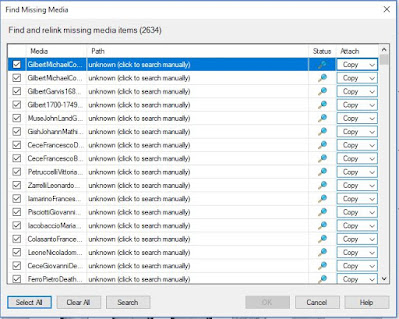Is your family tree research more productive when you focus on one person? Or do you happily follow leads and create new branches all the time?
You can fortify your family tree by filling in the blanks for your closest relatives. Then you can move on to those tempting new branches.
If you have a few moments to yourself this holiday season, think about your specific genealogy research goals for the new year. Working your way down your list of specific goals will make your tree stronger, faster.
Here are some suggestions for creating your genealogy goals for 2018.
 |
| My grandparent chart shows me exactly who's missing. |
Find Specific Ancestors
My grandparent chart showed me that I needed the most work on my mother's mother's family. When I saw how much further I'd gotten with every other branch of my tree, I decided to focus on Grandma's line. I made great strides! See
Today I Demolished My Family Tree's Only Brick Wall.
Your chart can show you where your tree needs the most work. Your goal might be "Find my 4th great grandparents in my paternal grandfather's line."
 |
| My document tracker shows me which documents I have and don't have. |
Fill in What's Missing
A few years into my genealogy research, I had a big collection of downloaded documents: census forms, ship manifests, draft registrations cards, and more. My filing system is very logical, so I can find what I need in a heartbeat.
But with such a big collection, it was hard to know if I was busy searching for something I had already. See
Haven't I Seen You Before?
My document tracker spreadsheet gives me a quick way to see what I have for a person and what I'm missing.
Another of your goals for 2018 could be to "Find every missing 1940 census for the people in my tree."
Request Official Documents
I wish every document I needed for my family tree were online. But sometimes you've got to request a marriage certificate from the state, or buy a copy of a death certificate from the Department of Health.
If some of your ancestors died not so long ago, it's unlikely you'll find their death records online. You've got to find out how to order a copy from the state where your ancestor died.
I wanted a copy of my grandfather's 1992 death certificate to learn his exact cause of death. My brother, my cousins, and I knew it was two types of cancer, but we weren't sure which types. As his direct descendants, we thought we should know.
Since my grandfather died in New York City, I had to request a copy in a certain way. If he'd died somewhere else in New York state, or in another state, I would have had to follow a different procedure.
P.S. They did not send me his full death certificate, so I still don't know his official cause of death.
Your goal for 2018 might be "Get copies of birth, marriage and death records for my grandparents and great grandparents."
Confirm or Debunk Family Lore
I have two pieces of family lore that are so vague, I may never be able to confirm or debunk them.
One story says that my great grandfather's brother, Agostino, left the Bronx and moved to Chicago because he was involved in a fight that left a man dead.
I can try to pinpoint when he left the Bronx, and then search newspapers for a story about a man dying in a big brawl.
Another story says that my great grandfather Pasquale left New York and moved to Ohio because of an injury. He and his brothers-in-law worked for the railroad. One of the men let his son into a restricted area. The boy did something stupid and lost a few toes in an accident. To avoid getting fired, they packed up and moved.
The men continued working for the railroads. I suspect the railroad in Youngtown, Ohio, needed workers. They may have gotten an incentive to go work there.
But if the story were true, there might be some documentation of the boy with the missing toes.
Newspaper research could be what you need to confirm or debunk your family stories. Your goal might be "Find proof for my cousin's claim about our ancestor."
Aim for five or six goals that will provide the most bang for your research buck. If you achieve these goals, imagine how much family tree research you will accomplish in 2018!


















